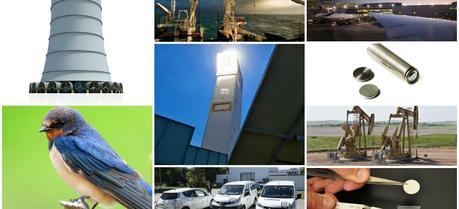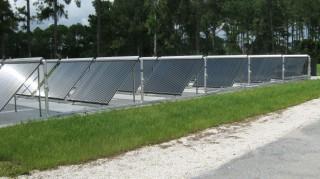
According to a new report by the International Energy Agency, electricity will increasingly power the world’s economies in the 21st century, rivaling oil as the dominant energy carrier. With that in mind, this month’s review focuses on energy news on both conventional and renewable energy technologies, specifically wind and solar energy, oil and natural gas development, energy storage and electric mobility.
Wind Energy
In the beginning of May, Xcel Energy, a utility holding company based in Minneapolis, Minnesota, serving more than 3.3 million electric customers and 1.8 million natural gas customers, achieved a milestone when wind power met 46% of customers’ electricity needs in the company’s Upper Midwest service territory. At the time the company’s Upper Midwest record was set, wind resources provided 1,622 megawatts of the 3,512 megawatts Xcel Energy’s customers were using in Minnesota and neighboring states. The previous record was set in April 2013, when wind generation met 42% of customer demand.
SEE ALSO: April, 2014: This Month in Energy
Meanwhile, Solar Wind Energy Tower, Inc. got an approval for the development of the first “solar wind downdraft tower,” a hybrid solar-wind power plant, in San Luis, Arizona. This novel hybrid solar-wind power plant is comprised of a tall hollow cylinder with a water injection system near the top and wind tunnels containing turbines near the bottom.
Two studies investigated ways to optimize offshore wind development. According to the first, rerouting ships to open up areas for offshore wind development could save billions of dollars in construction and operating costs for the renewable energy source. The second one is working to identify effective means of exploiting existing offshore installations simultaneously for offshore wind farms, wave energy systems and different kinds of aquacultures for fish- and seaweed farms.
Solar Energy
In May, NRG Energy, Inc. along with partner MidAmerican Solar announced they have achieved substantial completion at their Agua Caliente Solar Photovoltaic Facility, a 290 MW photovoltaic facility located on 2,400 acres of land between Yuma and Phoenix, Arizona. Agua Caliente is currently the world’s largest fully operational solar photovoltaic facility.
As for concentrated solar power, the German Aerospace Center has developed a new type of radiation receiver that uses ceramic particles for solar energy heat transfer and storage. The particles are held in a drum inside the rotating receiver by centrifugal force, until they become hot enough to drive the steam turbine in a power plant.
More traditional solar thermal panels got an efficiency upgrade, thanks to the Swiss Federal Institute of Technology in Lausanne (EPFL). The scientists there have improved the black coating used for thermal sensors and developed an original and patented method for depositing the coating.
The most popular posts in May, 2014
1. IRENA: 6.5 M People Employed in Renewable Energy Worldwide
2. Scientists Print Fuel Cells With Ordinary Inkjet Printer
3. Power Japan Plus Claims a Breakthrough in Battery Tech
4. Scientists to Make Plants More Efficient at Photosynthesis
5. Structural Supercapacitor Stores Energy, Bears Mechanical Load
Hybrid and Electric Cars
Chalmers researcher Viktor Larsson has developed a method to make the car remember the commuter routes and thereby make optimal use of the battery. The strategy can reduce fuel consumption by up to 10% compared to conventional methods. Apparently, the method can be implemented in vehicles that are already in production, using existing technology.
In the meantime, the RheinMobil project, a joint project of Michelin, Siemens, Karlsruhe Institute of Technology (KIT), the Fraunhofer Institute for Systems and Innovation Research ISI, and the mobility services company e-Motion Line (eML), has proved that a combination of quick and conventional charging ensures a high utilization rate of electric vehicles and protects the battery.
In collaboration with the Swedish Transport Administration, the Volvo Group is looking for a radical solution to electric vehicle charging. The company is studying the potential for building electric roads, where city buses can be charged from electricity in the road at the same time as the bus is in operation. A 300- to 500-meter (984 to 1640 ft.) electric road may be built for test operations in central Gothenburg, Sweden, during 2015.
Batteries and Supercapacitors
Last month, Power Japan Plus launched a new battery technology—the Ryden dual carbon battery. The company claims that this new battery offers an energy density comparable to a lithium ion battery, but over a much longer functional lifetime with drastically improved safety and cradle-to-cradle sustainability. If the company is to be believed, the dual carbon battery may be the future of energy storage.
Nevertheless, lithium-ion batteries may have an ace up their sleeve—a group of researchers at the University of California, Riverside Bourns College of Engineering have developed a new way to make lithium-ion batteries that will last three times longer between charges compared to the current industry standard.
Supercapacitors are also not to be dismissed. For example, researchers at the University of California, Riverside have developed a novel nanometer scale ruthenium oxide anchored nanocarbon graphene foam architecture that improves the performance of supercapacitors, a development that could mean faster acceleration in electric vehicles and longer battery life in portable electronics. And Vanderbilt University scientists have developed a structural supercapacitor that efficiently stores electricity and can simultaneously bear mechanical load. This discovery has a wide range of potential applications, such as a laptop whose casing serves as its battery.
Oil and Natural Gas
While natural gas can reduce greenhouse emissions when it is substituted for higher-emission energy sources, abundant shale gas is not likely to substantially alter total emissions without policies targeted at greenhouse gas reduction, a pair of Duke researchers found out.
Some of that reduction could be achieved with a new technology that converts excess carbon dioxide and wastewater from the oil and gas sector into reusable water and valuable chemicals. This development could serve the dual purpose of reducing global carbon dioxide emissions and addressing the issue of decreasing global water reserves.
And the water used in oil and natural gas development can be used more efficiently. According to scientists from the MESA+ research institute of the University of Twente, oil extraction techniques can be significantly improved by using water with a lower salt content when drilling. It was already clear that, in order to achieve maximum results, the water used should not be too salty, but until recently the exact role of the salt ions in the process was unclear.
Still, oil and natural gas development has its effect on the environment. According to researchers in Penn State’s College of Agricultural Sciences, conventional oil and gas development in northern Pennsylvania altered bird communities, and the current massive build-out of shale-gas infrastructure may accelerate these changes.
This month in photos: May 2014

A Vanmoof electric bike. (Credit: Vanmoof)

An innovative idea to provide outdoor lighting using wind-solar hybrid renewable energy sources. (Credit: Reseacrh SEA)

Solar thermal panels installed at Naval Submarine Base Kings Bay. (Credit: Quentin Bowen, NAVFAC Southeast Engineering Technician / U.S. Navy)

Researchers transform an ordinary HP 1000 ink jet printer to print fuel cells. (Credit: Technical University of Denmark)

A batteryless electrostimulator next to medicinal pills for size comparison. The new powering method allows the device to be wirelessly powered deep inside the body. (Credit: Austin Yee / Stanford University)

The successful first public flight of the electric E-Fan experimental aircraft took place during the E-Aircraft Day in Bordeaux on the 25th of April 2014. The electric E-Fan training aircraft is a highly innovative technology experimental demonstrator based on an all-composite construction. (Credit: Airbus Group)

